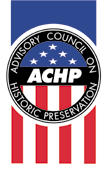 About ACHP
About ACHP ACHP News
National Historic
Preservation
Program
Working with
Section 106
Federal, State, & Tribal Programs
Training & Education
Publications
Search
Home
ACHP Faults Navy Plan for Failure to Preserve Pensacola Historic Structures
For more information, contact Bruce Milhans at (202) 606-8513
or bmilhans@achp.gov
|
|
Washington, DC—Following a fact-gathering tour and public meeting in Pensacola, Florida, on August 8, 2005, the Advisory Council on Historic Preservation (ACHP) issued recommendations faulting the U.S. Navy plans to demolish all but three of 16 significant historic structures in the Pensacola Naval Air Station Historic District, and urging preservation and appropriate reuse of most of the buildings at issue.
The ACHP recommendation consents to the destruction of four of the 16 buildings that would be particularly difficult to preserve or reuse, but strongly urges the preservation and reuse of 12 of the threatened structures.
"We have concluded that the Navy set into motion plans for extensive demolition of historic properties without considering the unique historic value of these properties. Once committed to this course of action, the Navy became unwilling to rethink its earlier flawed planning assumptions," stated the recommendations letter sent to Secretary of the Navy Gordon R. England.
That letter was signed by John L. Nau, III, ACHP chairman, who with four other ACHP members comprised the panel considering the issue.
The ACHP agreed with the Navy's proposal to save three buildings, but called for it to re-evaluate plans and find alternatives to demolishing nine of the remaining 16 historic structures damaged by Hurricane Ivan on September 15, 2004.
The recommendation was grounded in preservation analysis reports (PARs) on each of the 16 properties that examined historic and architectural value, assessed damage, and estimated costs of various treatment options.
These PARs demonstrated that each of the 16 buildings were structurally sound and repairable, and concluded that the cost estimates for demolition exceeded the estimates for "mothballing" them.
The ACHP panel found the Navy's demolition plans "contrary to the Navy's responsibilities under Section 110(f) of the National Historic Preservation Act, which directs Federal agencies to undertake to the maximum extent possible, planning and actions to minimize harm to a National Historic Landmark, and the stewardship goals of Executive Order 13287, 'Preserve America.'"
In addition to Nau, the ACHP panel members were Susan Barnes, expert member; John G. Williams, expert member; Mark Rey, Under Secretary for Natural Resources and Environment, representing the U.S. Secretary of Agriculture; and, George Schoener, Deputy Assistant Secretary for Transportation Policy, representing the U.S. Secretary of Transportation.
Read a copy of the letter to the Secretary of the Navy (in PDF)
Background
Hurricane Ivan caused extensive damage to Naval Air Station Pensacola and its environs on September 15, 2004. On October 6, 2004, The U.S. Navy notified the National Parks Service, the Florida State Historic Preservation Officer, and the ACHP that it intended to proceed under emergency provisions in the ACHP's regulations to repair and demolish historic properties on the base.
Agreement was reached to allow demolition on all but the 16 structures considered of greatest significance in the Pensacola Naval Air Station Historic District, a National Historic Landmark covering 82 acres.
This site includes remains of the 19th century Pensacola Navy Yard, the Nation's first Naval Air Station, and the first Navy pilot training center in the United States. The Navy, however, decided to proceed with demolition of all but three of these 16 structures.
Read the ACHP Case Digest summary of this case
About
the ACHP
The ACHP, an independent Federal agency, promotes the preservation,
enhancement, and productive use of the nation's historic resources and advises
the President and Congress on national historic preservation policy. It also provides
a forum for influencing Federal activities, programs, and policies that impact
historic properties. In addition, the ACHP has a key role in carrying out the
Administration's Preserve America program. Visit www.achp.gov for more information.
Posted September 12, 2005
